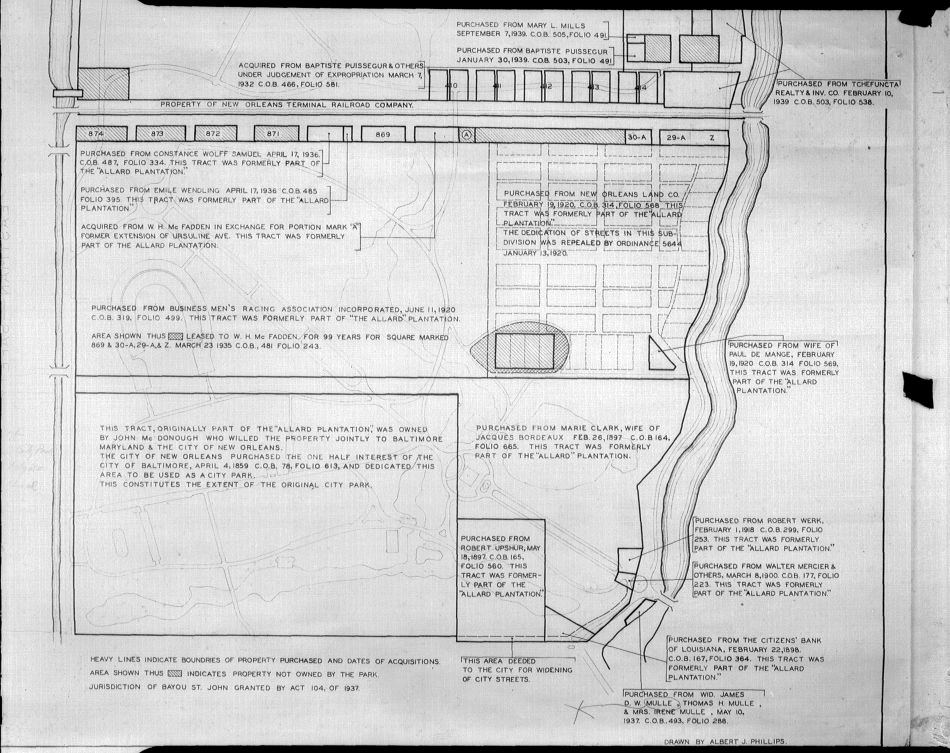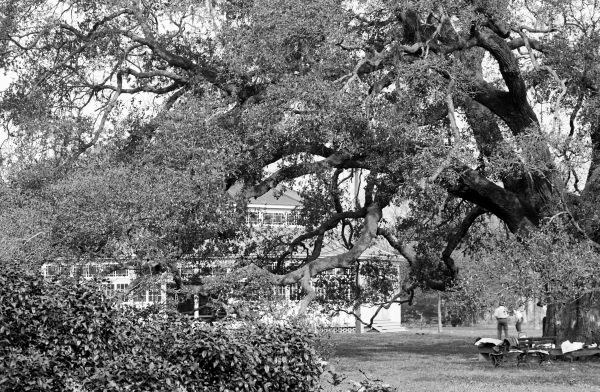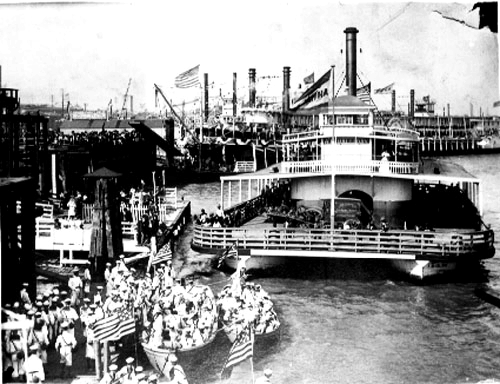|
Today in New Orleans History |
|
|
October 26


He was a soldier in the Louisiana Regiment which fought in
the battle of Chalmette Plains (Chalmette Battlefield) under General Andrew Jackson. McDonogh was a founding member
of the American Colonization Society which reportedly provided passage for 18,000 slaves to the Liberian Republic. In 1842
McDonogh oversaw the shipping of 80 slaves who had 'bought' their freedom after work credited to their accounts equaled their
market value. After McDonogh purchased what would become City Park in an 1845
Sheriff's sale (654 acres, 19 slaves, 10 horses and mules, 140 head of cattle bought for $40,000.), he allowed Louis Allard
to live the remainder of his life there. It is often said that Allard was buried in a quiet spot under a favorite tree (the
Dueling Oak) however St. Louis Cathedral records indicate that Allard was buried on May 18, 1847 in St. Louis Cemetery #2. McDonogh also left
$400,000 to the Protestant Male Orphan Home, required that a number of his negroes would be freed and moved to Africa. and
stipulated that none of his property could ever be sold, but would remain forever as a fund for the above charitable purposes.
Much of his bequest was used to build schools but a portion of his property was set aside for the park. The 4th District Court's
1854 designation of approximately 100 acres of the property as a public park makes it one of the oldest in the nation The city sold much of the Allard/McDonogh property including the bayou frontage but would buy much of it
back later. In 1867 a park keeper was hired to cut the grass on a salary of $80 while illegally selling it for hay, chopping
trees to sell wood, and taking in $15,000 per year charging fees for the grazing of 50 goats, 25 mules, 100 horses, and hundreds
of cows. During the 1870's the keeper, E. A. Pegroux, appointed Jean Marie Saux to oversee the park and tend the cattle.
Saux also sold wood from trees cut in the park – while running his coffeehouse across from it which is now Ralph's
on the Park restaurant. An 1870 legislative act authorized the city to levy a real-estate tax to establish "a
New Orleans Park" and a Board of Commissioners was appointed. In 1871 prisoners were used to make some improvements.
In 1877 the board was abolished and the City Council took over the park's management. The land was roughly fenced in 1880
“to keep cows from neighboring pastureland from becoming a further nuisance”. In 1881 new commissioners
were appointed – including J.M. Saux (the coffeehouse owner). In 1882 the portion of park west of Orleans Canal was
detached for use as small-pox hospital and cemetery. Picayune's Guide to New Orleans 1903 stated “The park contains
216.60 acres, only a portion of which, however, has been improved”. Board member George G. Friedrichs advocated renaming the park for John McDonogh (45 years after his death).
The CPIA contested that 30 schools had already been named for him and that he had originally donated half of his land to Baltimore.
The Daily Picayune reported on November 30, 1895, ”If the name McDonogh Park was substituted, there would be nothing
the Commissioners to do but resign...An unfavorable report was made of the ordinance”. It is possible that McDonogh's
reputation as an unsociable tight-wad (known as “McDonogh the Miser”) still weighed on the commission’s
mind. Friedrich was a realtor also made a fortune in land and a street in the park is named for Friedrichs. It runs from Wisner
Boulevard to Henry Thomas Drive as it passes Christian Brothers School. Top photo from the New Orleans Public Library.
Text from New Orleans City Park and Metaiire, both by Catherine Campanella.
A city ordinance Designated Claiborne Avenue neutral ground from Canal to Julia Streets and the triangle at the corner of Tulane and Claiborne. Opened as a playground on October 26, 1909.
Teddy Roosevelt in New Orleans The ferry boat A.M.Halliday, photographed at dock during the visit of President Theodore Roosevelt
to New Orleans, October 26, 1905. The river played a key role in the festivities that day. The President
entered the city by ship, was greeted at the Stuyvesant Docks by Governor Blanchard, Mayor Behrman and other dignitaries and
taken on the S.S. Comus for a river up to Audubon Park and back around down to the Algiers Naval Station. The river was packed
with sightseers in every describable kind of vessel out to catch a glimpse of TR--among them the passengers of the A.M. Halliday.
After an address and luncheon at the St. Charles Hotel, the President ended his visit--again at the river, as he sailed away
to the Gulf on the Magnolia. The Daily Picayune reported that Roosevelt was delighted with his visit, impressed by the activity
and extent of the Port and by the enthusiastic welcome given him by the residents of the Crescent City.
On a "normal" day, the ferry provided the only public access between New Orleans and Algiers. In the absence of
a bridge, even passenger trains had to be floated across the river on huge railroad ferryboats. The Southern Pacific Railroad
trains crossed the river by ferry from the Southern Pacific yard in Algiers to the line's terminal at the foot of Elysian
Fields. [New Orelans Public Libary David Barrow Fischer Steamboat Collection] For much of the
19th century, the right (or west) bank of the Mississippi, including the city of Algiers, was governed by its own Police Jury,
entirely separate from the government in New Orleans. Algiers was incorporated into the City of New Orleans in 1870 as the
5th Municipal District, but this legal merging of the two sections could not erase the very real barrier that the great river
had inevitably created between New Orleans and Algiers. Although ferries have provided access to the West Bank of the river
from earliest times, the river has historically served as a divider between the city's two shores. While New Orleans boomed
into a thriving metropolis in the years before the Civil War, Algiers--less than a mile away as the crow flies--stayed small
and kept itself relatively isolated from the hustle and glitter on the east bank. Many Algiers residents rode the ferry
to work each day, but many more remained on their side of the river, earned their livings on or near its banks, and valued
the calmer pace of small town life offered on the West Bank. It was not until the twentieth century and the opening of the
Huey P. Long Bridge in 1935 and, more significantly, the Greater New Orleans Bridge in 1958 (renamed the Crescent City Connection
when its second span opened thirty years later) that the wide expanse of water separating the East and West banks metaphorically
narrowed. In spite of the increased ease of movement between the east and west bank today, however, old habits and attitudes
die hard, and the two banks remain in many ways distinct and separate--by choice now, perhaps, rather than by necessity. Algiers' first public ferry was established in 1827, when the Louisiana legislature granted August Coycault
and Barthelemy Gosselin a contract to operate a steam ferry from the foot of Patterson Street on the west bank to Jackson
Square on the east bank. In 1834, a second ferry was added, its dock at de la Ronde Street and its east bank landing at St.
Louis Street (moved later to Canal St.). And in 1858 a third ferry--the Third District Ferry began to run from Verret Street
to Esplanade Ave; this later became the ferry that transported railroad cars across the river. The location of the landings
of these three ferries shifted from time to time and additional routes were added, and the ferry business prospered until
the Greater New Orleans Bridge opened in 1958 and the boats lost their practicality. Today, only the Canal Street Ferry remains
of the original three and the "Lower Coast" of Algiers is now being served by the Chalmette Ferry. Photo
and text from the New Orleans Public Library. |
|
|

To receive an update for each day in New Orleans history,
join our facebook page - Today in New
Orleans History.
Analytics |


 On October 31, 1860, Allard's remaining land was up for Sherriff's auction. It was described as "fronting the park and
partly on Metairie Road with Bayou St. John and the Orleans Canal. 40 arpents front on Metairie Road. Depth 18
arpents (a French unit of measure slighlty smaller than an acre) on each side 45 arpents on rear line. except City Park,
formerly Allard's Place and a parcel of land n Bayou St. John. Will be sold as a bloc, and subject to a lease which
includes the user of 16 negroes. $1600 per annually. Sold to John McDonogh".
On October 31, 1860, Allard's remaining land was up for Sherriff's auction. It was described as "fronting the park and
partly on Metairie Road with Bayou St. John and the Orleans Canal. 40 arpents front on Metairie Road. Depth 18
arpents (a French unit of measure slighlty smaller than an acre) on each side 45 arpents on rear line. except City Park,
formerly Allard's Place and a parcel of land n Bayou St. John. Will be sold as a bloc, and subject to a lease which
includes the user of 16 negroes. $1600 per annually. Sold to John McDonogh". 


